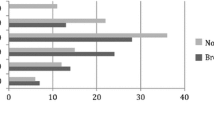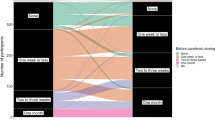Abstract
Although methadone maintenance treatment (MMT) is an important means of HIV control, MMT clinics commonly have high attrition rates. The randomized controlled trial investigated the relative efficacy of adding a psycho-social intervention to the standard-of-care MMT in reducing attrition and non-attendance among first-time newly admitted MMT users in China (n = 288). Social workers implemented this three-phase intervention that was based on a behavioral maintenance theory. It also involved participants’ family members and rectified some MMT-related misconceptions. As compared to the control group, the intervention group showed significantly lower likelihood of attrition (HR = 0.55, 95 % confidence interval 0.39–0.80), lower estimated probability of attrition at Month 12 (0.35 vs. 0.55), and higher median number of days of attendance (Month 6: 147 vs. 91 days, p < 0.001; end-date: 225 vs. 142 days, p < 0.001). Further psycho-social services and translational research are warranted.


Similar content being viewed by others
References
Ministry of Health, People’s Republic of China, Joint United Nation Programme on HIV/AIDS, World Health Organization. 2011 Estimates for the HIV/AIDS Epidemic in China. Beijing: Ministry of Health, People’s Republic of China; 2011.
Yin W, Hao Y, Sun X, et al. Scaling up the national methadone maintenance treatment program in China: achievements and challenges. Int J Epidemiol. 2010;39 Suppl 2:ii29–37.
Zhang C, Yang R, Xia X, et al. High prevalence of HIV-1 and hepatitis C virus coinfection among injection drug users in the southeastern region of Yunnan China. J Acquir Immune Defic Syndr. 2002;29(2):191–6.
State Council AIDS Working Committee Office, UN Theme Group on HIV/AIDS in China. A Joint Assessment of HIV/AIDS Prevention, Treatment and Care in China. Beijing; 2004.
Lau JTF, Cheng F, Tsui H, et al. Clustering of syringe sharing and unprotected sex risk behaviors in male injecting drug users in China. Sex Transm Dis. 2007;34(8):574–82.
Kleber HD. Methadone maintenance 4 decades later: thousands of lives saved but still controversial. JAMA. 2008;300(19):2303–5.
Clausen T, Anchersen K, Waal H. Mortality prior to, during and after opioid maintenance treatment (OMT): a national prospective cross-registry study. Drug Alcohol Depend. 2008;94(1–3):151–7.
Gottheil E, Sterling RC, Weinstein SP. Diminished illicit drug use as a consequence of long-term methadone maintenance. J Addict Dis. 1993;12(4):45–57.
Gowing L, Farrell M, Bornemann R, Sullivan L, Ali R. Substitution treatment of injecting opioid users for prevention of HIV infection. Cochrane Database Syst Rev. 2008; (2):CD004145.
Marsch LA. The efficacy of methadone maintenance interventions in reducing illicit opiate use, HIV risk behavior and criminality: a meta-analysis. Addiction. 1998;93(4):515–32.
Mattick RP, Breen C, Kimber J, Davoli M. Methadone maintenance therapy versus no opioid replacement therapy for opioid dependence. Cochrane Database Syst Rev. 2009(3):CD002209.
Verthein U, Bonorden-Kleij K, Degkwitz P, et al. Long-term effects of heroin-assisted treatment in Germany. Addiction. 2008;103(6):960–6.
Effective medical treatment of opiate addiction. National Consensus Development Panel on Effective Medical Treatment of Opiate Addiction. JAMA. 1998;280(22):1936–43.
Pang L, Hao Y, Mi G, et al. Effectiveness of first eight methadone maintenance treatment clinics in China. AIDS. 2007;21(Suppl 8):S103–7.
Tang Y, Zhao D, Zhao C, Cubells J. Opiate addiction in China: current situation and treatments. Addiction. 2006;101(5):657–65.
Qian HZ, Schumacher JE, Chen HT, Ruan YH. Injection drug use and HIV/AIDS in China: review of current situation, prevention and policy implications. Harm Reduct J. 2006;3:4.
Encrenaz G, Rondeau V, Messiah A, Auriacombe M. Examining the influence of drop-outs in a follow-up of maintained opiate users. Drug Alcohol Depend. 2005;79(3):303–10.
Davstad I, Stenbacka M, Leifman A, Beck O, Korkmaz S, Romelsjo A. Patterns of illicit drug use and retention in a methadone program: a longitudinal study. J Opioid Manag. 2007;3(1):27–34.
Li XL, Tan HZ, Sun ZQ, Zhang H, Chen MS, Ou QY. [tudy on the time of retention and related influencing factors of patients receiving methadone maintenance treatment in Hunan province. Zhonghua Liu Xing Bing Xue Za Zhi (in Chinese). 2009;30(7):672–5.
Ministry of Health of China (MOH), Ministry of Public Security of China, State Food and Drug Administration (SFDA). Work plan of community maintenance treatment for opioid addicts. Retrieved August 31, 2010, from www.chinaaids.cn/worknet/download/2005/0308.doc.
Lin C, Wu Z, Rou K, et al. Challenges in providing services in methadone maintenance therapy clinics in China: service providers’ perceptions. Int J Drug Policy. 2011;21(3):173–8.
Wang Q, Lin G. Sex exchange and HIV-related risk behaviors among female heroin users in China. J Drug Issues. 2003;33(1):119–32.
Coviello DM, Zanis DA, Wesnoski SA, Domis SW. An integrated drug counseling and employment intervention for methadone clients. J psychoactive drugs. 2009;41(2):189–97.
Scherbaum N, Kluwig J, Specka M, et al. Group psychotherapy for opiate addicts in methadone maintenance treatment—a controlled trial. Eur Addict Res. 2005;11(4):163–71.
Amato L, Minozzi S, Davoli M, Vecchi S, Ferri MM, Mayet S. Psychosocial combined with agonist maintenance treatments versus agonist maintenance treatments alone for treatment of opioid dependence. Cochrane Database Syst Rev. 2008; (4):CD004147.
Chawarski MC, Zhou W, Schottenfeld RS. Behavioral drug and HIV risk reduction counseling (BDRC) in MMT programs in Wuhan, China: a pilot randomized clinical trial. Drug Alcohol Depend. 2011;115(3):237–9.
Hser YI, Li J, Jiang H, et al. Effects of a randomized contingency management intervention on opiate abstinence and retention in methadone maintenance treatment in China. Addiction. 2011;106(10):1801–9.
Zhong F, Xu H, Zhao Y. Multiple approaches to estimate the population size of drug users in a municipality. Journal of Tropical Medicine (in Chinese). 2007;7:1113–5.
Rothman AJ. Toward a theory-based analysis of behavioral maintenance. Health Psychol. 2000;19(1 Suppl):64–9.
Sarasvita R, Tonkin A, Utomo B, Ali R. Predictive factors for treatment retention in methadone programs in Indonesia. J Subst Abuse Treat. 2012;42(3):239–46.
National Institute on Drug Abuse (NIDA). Principles of Drug Addiction Treatment. A Research-Based Guide (Second Edition) 2009.
Lev-Wiesel R, Shuval R. Perceived causal and treatment factors related to substance abuse: gender differences. Eur Addict Res. 2006;12(2):109–12.
Gu J, Xu H, Lau JT, et al. Misconceptions predict prospectively dropout and poor adherence among newly admitted first-time methadone maintenance treatment clients in Guangzhou, China. Addiction. 2012;107(9):1641–9.
Hao C, Wu JL, Ruan YH, et al. Factors associated with retention in a community-based methadone maintenance treatment among heroin addicts. Zhonghua Yu Fang Yi Xue Za Zhi (in Chinese). 2007;41(4):250–3.
Liu E, Liang T, Shen L, et al. Correlates of methadone client retention: a prospective cohort study in Guizhou province, China. Int J Drug Policy. 2009;20(4):304–8.
Wilcoxon F. Individual comparisons of grouped data by ranking methods. J Econ Entomol. 1946;39:269.
Nicholls L, Bragaw L, Ruetsch C. Opioid dependence treatment and guidelines. J Manag Care Pharm. 2010; 16(1 Suppl B):S14–21.
Exner T, Seal D, Ehrhardt A. A review of HIV interventions for at-risk women. AIDS Beha. 1997;1(2):93–124.
Kondo A, Wada K. The effectiveness of a mutual-help group activity for drug users and family members in Japan. Subst Use Misuse. 2009;44(4):472–89.
Lin C, Wu Z, Detels R. Family support, quality of life and concurrent substance use among methadone maintenance therapy clients in China. Public Health. 2011;125(5):269–74.
Tang A, Liang HJ, Ungvari GS, Tang WK. Referral patterns and clinical characteristics of subjects referred to substance abuse clinic of a regional hospital in Hong Kong. East Asian Arch Psychiatry. 2011;21(1):22–7.
Department of Health (England) and the devolved administrations. Drug Misuse and Dependence: UK Guidelines on Clinical Management. London: Department of Health (England), the Scottish Government, Welsh Assembly Government and Northern Ireland Executive; 2007.
Mayet S, Farrell M, Ferri M, Amato L, Davoli M. Psychosocial treatment for opiate abuse and dependence. Cochrane Database Syst Rev; 2005(1):CD004330.
Kim SS, Kaplowitz S, Johnston MV. The effects of physician empathy on patient satisfaction and compliance. Eval Health Prof. 2004;27(3):237–51.
Acknowledgments
The authors would like to thank Chujun Xu, Wenliang Pan and Jiangqiang Li of the Big Dipper Social Work Center, who conducted the intervention and collected the data of the study. The authors would also like to thank all staff of the MMT clinics and all participants of the study. Thanks were extended to Ms. Yingna Liu who edited the English of the paper. This study was supported by National Natural Science Foundation of China (30901226), the Fundamental Research Funds for the Central Universities (2009158) and the CMB HPSS (11-074).
Author information
Authors and Affiliations
Corresponding author
Rights and permissions
About this article
Cite this article
Gu, J., Lau, J.T.F., Xu, H. et al. A Randomized Controlled Trial to Evaluate the Relative Efficacy of the Addition of a Psycho-Social Intervention to Standard-of-Care Services in Reducing Attrition and Improving Attendance Among First-Time Users of Methadone Maintenance Treatment in China. AIDS Behav 17, 2002–2010 (2013). https://doi.org/10.1007/s10461-012-0393-9
Published:
Issue Date:
DOI: https://doi.org/10.1007/s10461-012-0393-9




